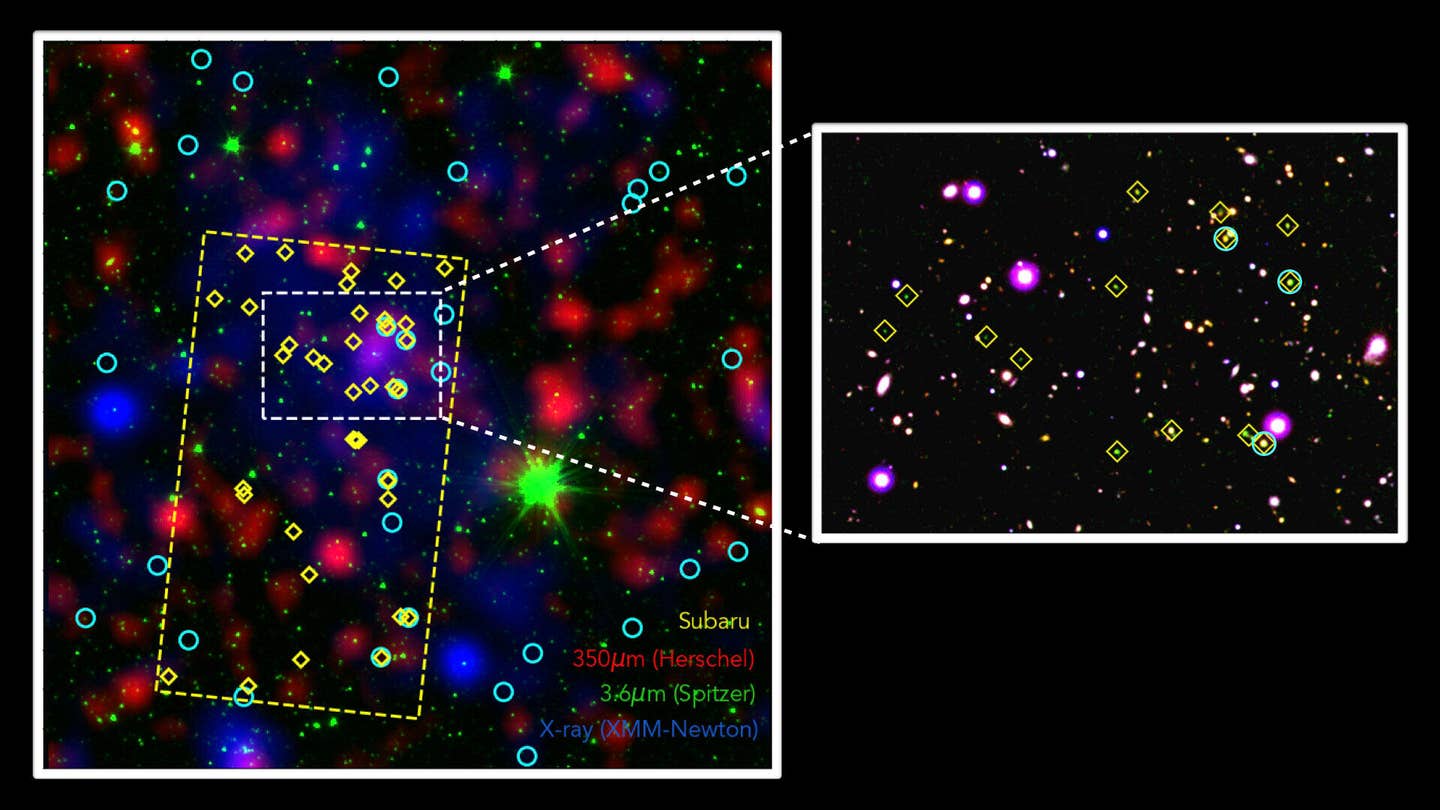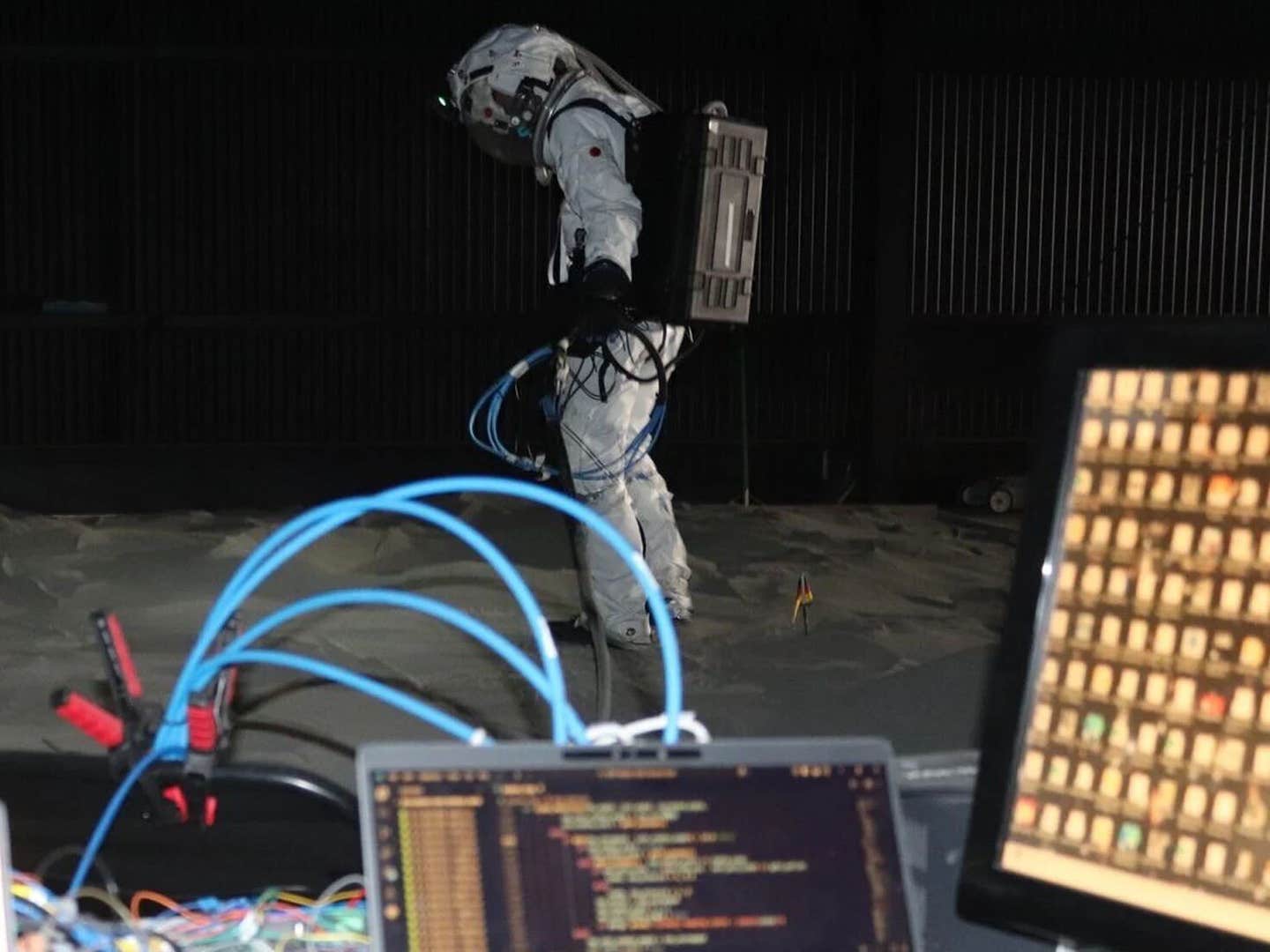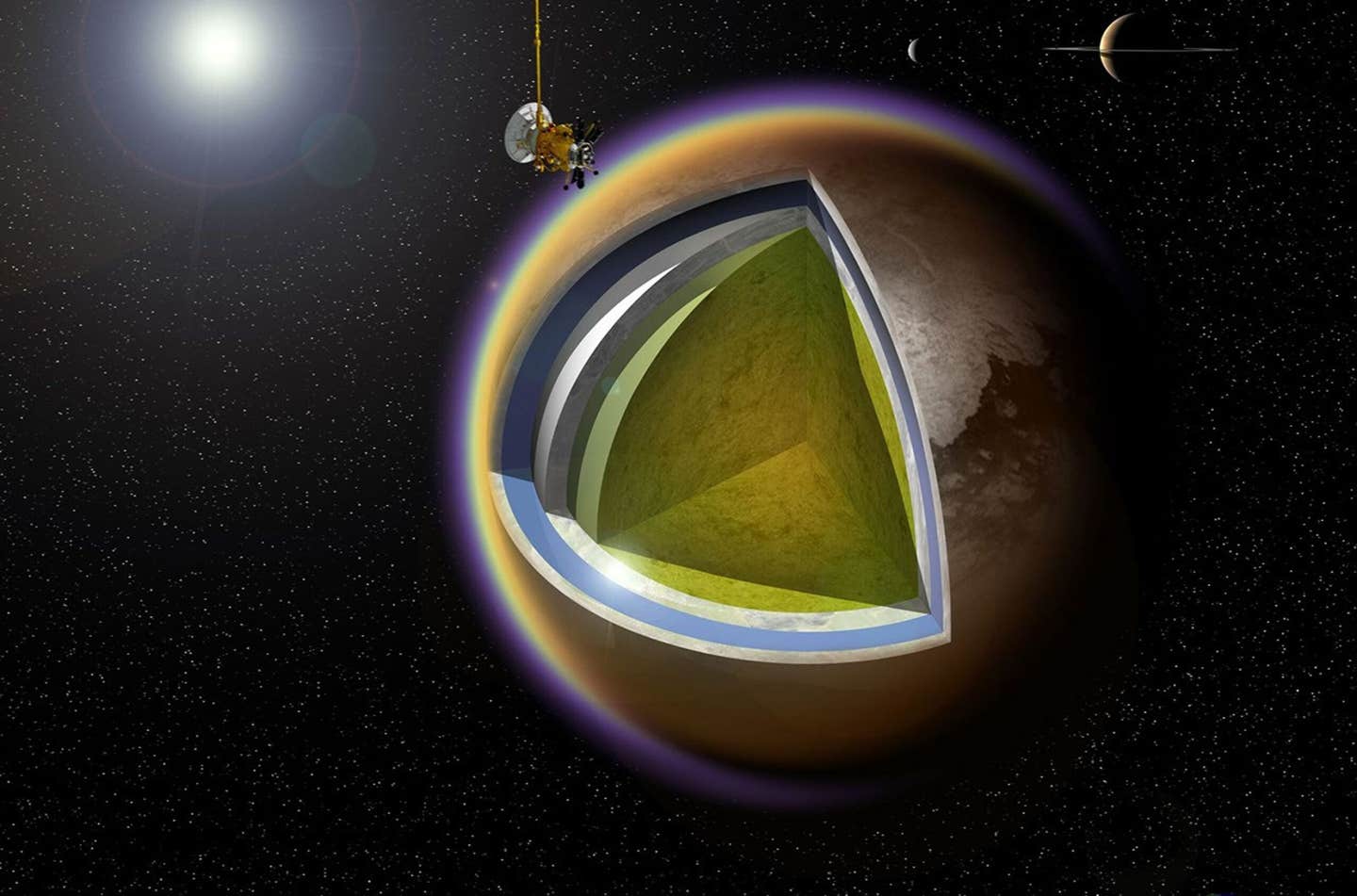Astronomers discover a massive galaxy ‘shipyard’ in the distant universe
Astronomers have reported the discovery of a structure thought to be a “protocluster” of galaxies 11 billion light-years from Earth.

[Oct 27, 2021: Large Binocular Telescope Observatory]
Sky region showing the PHz G237 protocluster and the identified galaxy members. The left panel shows a multi-band image (11 arcmin x 11 arcmin) combining the Herschel sub-millimeter image at 350 micron in red (star formation tracer), the Spitzer image at 3.6 micron in green (stellar mass tracer), and the XMM-Newton X-ray image in blue (tracer of accreting supermassive black holes). The region observed with the Subaru Telescope is delimited by a yellow dashed rectangle. Galaxy members identified through observations with the Subaru Telescope are shown as yellow diamonds, and the galaxies identified spectroscopically are shown as light blue circles. The right panel shows a zoom in the central 2.7 arcmin x 1.9 arcmin region of the protocluster (red: 2.14 micron, green: 2.07 micron, blue: 1.25 micron). (Credit: ESA/Herschel and XMM-Newton; NASA/Spitzer; NAOJ/Subaru Telescope; Large Binocular Telescope; ESO/VISTA; Polletta et al. 2021; Koyama et al. 2021)
An international team of astronomers has reported the discovery of a structure thought to be a "protocluster" of galaxies on its way to developing into a galaxy supercluster. Located 11 billion light-years from Earth, the observations show the protocluster as it appeared when the universe was 3 billion years old, during an epoch when stars were produced at higher rates in certain regions of the cosmos.
Even galaxies don't like to be alone. While astronomers have known for a while that galaxies tend to congregate in groups and in clusters, the process of going from formation to friend groups has remained an open question in cosmology.
In a paper published in the Astronomy & Astrophysics journal, an international team of astronomers reports the discovery of objects that appear to be an emerging accumulation of galaxies in the making – known as a protocluster.
"This discovery is an important step toward reaching our ultimate goal: understanding the assembly of galaxy clusters, the most massive structures that exist in the universe," said Brenda Frye, an associate professor of astronomy at the University of Arizona's Steward Observatory and a co-author of the study.
A simulation of the cosmic web - a vast, three-dimensional “spider web” of gas filaments crisscrossing in the cosmos. Rather than being randomly distributed, galaxies tend to cluster at the nodes of the cosmic web, depicted by the red regions, forming protoclusters such as G237. (Credit: International Gemini Observatory-NOIRLab-NSF-AURA-G. L. Bryan-M. L. Norman)
To cite a local analog, the Milky Way, the galaxy that is home to our solar system, belongs to a galaxy cluster known as the Local Group, which in turn is a part of the Virgo supercluster. But what did a supercluster such as Virgo look like 11 billion years ago?
Related Stories
"We still know very little about protoclusters, in part because they are so faint, too faint to be detected by optical light," Frye said. At the same time, they are known to radiate brightly in other wavelengths such as the sub-millimeter."
Initially discovered by the European Space Agency's Planck telescope as part of an all-sky survey, this protocluster showed up prominently in the far-infrared region of the electromagnetic spectrum. Sifting through a sample of more than 2000 candidate objects—structures that could be in the process of becoming clusters – the researchers came across a protocluster designated as PHz G237.01+42.50, or G237 for short. The observations looked promising, but to confirm its identity required follow-up observations with other telescopes.
Led by Mari Polletta at the National Institute for Astrophysics, or INAF in Milan, Italy, the team conducted the observations using the combined power of the Large Binocular Telescope in Arizona, which is managed by UArizona, and the Subaru Telescope in Japan. As a result of this combined study, the team identified 63 galaxies belonging to the G237 protocluster. The original discovery was published in a paper (ui.adsabs.harvard.edu/abs/2021 … S.503L...1K/abstract), and follow-up observations were also obtained using archival data, the Herschel Space Observatory, and the Spitzer Space Telescope.
"You can think of galaxy protoclusters such as G237 as a galaxy shipyard in which massive galaxies are being assembled, only this structure existed at a time when the universe was 3 billion years old," Frye said. "At the same time, the genealogy may be closer than you think. Because the universe is homogeneous and the same in all directions, we think that the Milky Way may have docked at a protocluster node similar to G237 when it was very young."
At first, the observations of G237 implied a total star formation rate that was unrealistically high, and the team struggled to make sense of the data. The G237 protocluster seemed to be forming stars at a rate of 10,000 times that of the Milky Way, the authors note. At that rate, the protocluster is expected to rapidly use up its stellar fuel and subsequently settle down into a complex system similar to the Virgo supercluster.
"Each of the 63 galaxies discovered so far in G237 was like a star factory in overdrive," Frye said. "It's as if the galaxies were working on overtime to the assemble stars. The rate of production was unsustainable. As such a pace, the supply chains are expected to break in the near future, and in a way that permanently shuts down the galaxy shipyard."
Such high yields can only be maintained by a continuous injection of fuel, which for stars is hydrogen gas. Frye said the result required an efficient and unbroken supply chain that drew in unreasonably-large amounts of fresh gas to fuel the star-forming factories.
"We don't know where that gas was coming from," she said.
Later, the team discovered that some of the signal was coming from galaxies unrelated to the protocluster, but even after the irrelevant signals were removed, the total star formation rate remained high, at least a thousand solar masses per year, according to Poletta. For comparison, the Milky Way produces about one solar mass each year.
"The picture we have pieced together now is that of a successful galaxy shipyard which is working at high efficiency to assemble galaxies and the stars within them and and has an energy supply that is more sustainable," Frye said.
All galaxies in the universe are part of a giant structure that resembles a three-dimensional spider web shape called the cosmic web. The filaments of the cosmic web intersect at the nodes, which equate to the galaxy shipyards in the analogy used here.
"We believe that the filaments mediate the transfer of hydrogen gas from the diffuse medium of intergalactic space onto these hungry, newly forming protocluster structures in the nodes," Frye said.
Pointing to future research, Polletta said: "We are in the process of analyzing more observations on this and other Planck protoclusters with the goal of tracing the gas that gives birth to these newly-forming stars and feeds the supermassive black holes, to determine its origin and explain the observed extraordinary activity."
Frye said she is looking forward to combining data from the Large Binocular Telescope with planned observations using the James Webb Space Telescope, to be launched in December.
"Protoclusters offer an opportunity to investigate key questions in astronomy that only this new observatory can answer," she said, "such as what mechanisms drive the prodigious star formation, and when will the hydrogen supply run out, forcing this galaxy shipyard to close its doors and turn into a supercluster similar to the one our Milky Way is in?"
For more science and technology stories check out our New Discoveries section at The Brighter Side of News.
Like these kind of feel good stories? Get the Brighter Side of News' newsletter.
Tags: #New_Discoveries, #Space, #Astronomy, #Protoclusters, #Galaxy, #Telescopes, #The_Brighter_Side_of_News



